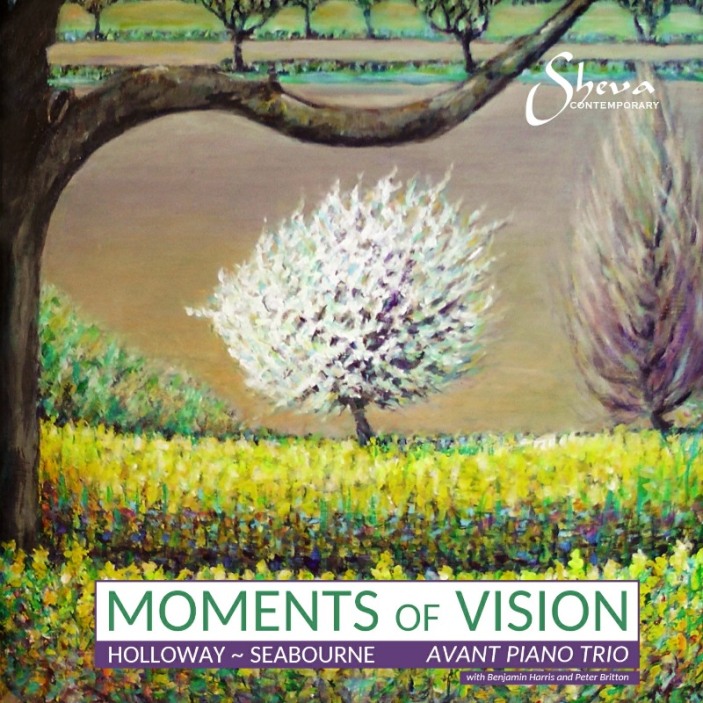
 HOLLOWAY: Piano Trio. Moments of Vision.* SEABOURNE: Piano Trio / Avant Piano Trio; *Benjamin Harris, spkr; Peter Britton, perc / Sheva Contemporary SH 271
HOLLOWAY: Piano Trio. Moments of Vision.* SEABOURNE: Piano Trio / Avant Piano Trio; *Benjamin Harris, spkr; Peter Britton, perc / Sheva Contemporary SH 271
This CD, scheduled for release in February, combines music by Peter Seabourne with that of his teacher and mentor Robin Holloway.
The Holloway trio, in one continuous movement lasting 20 minutes, features rising and falling chromatic lines over a very strange piano accompaniment in which extended chords are used. Yet it is an attractive piece and very well written, with its quirky theme developed strongly yet unexpectedly. I was rather surprised to learn that this is a late work by Holloway, dating from nearly four years ago (2017), as it has much of the freshness of his earlier works. In the liner notes, the composer describes parts of as being “operatic scenes” in an instrumental manner, sort of an opera without words. I found it utterly fascinating from start to finish. At about the 12:35 mark, the cello plays a pizzicato theme that sounds a bit, in the beginning, like the Te Deum motif. A bit later on, the violin and cello play very high, almost ghostly-sounding figures.
Much to my surprise, the Seabourne piano trio is considerably edgier than that of his teacher, opening with almost fragmented shards of notes scattered about at a fast speed, including some string tremolos played by the violinist. It is a tremendously busy work that almost sounds as if it keeps trying to coalesce, only to be split apart again and again by the nervous, kinetic energy of those little shards of phrases. We then go down a darker hole via the piano’s thumping chords, accompanied eventually by the strings. There is a brief motif that sounds, momentarily, like The Sorcerer’s Apprentice, the rhythm of which (if not the theme itself) returns a bit later. It almost sounds like a piano trio that is mad at each other, each instrument trying to argue against the others. The same vibe continues into the second movement, titled “Shadowy, rapid,” while the slow third movement provides a temporary respite from all the infighting—but not from the underlying unease of feeling. They may be quarreling a bit less, but there are still some hard feelings between them. In the last movement there seems to be an attempt at reconciliation, but perhaps too late: now that the trio has decided to play together, their different figures clash and trip over one another.
Holloway’s Moments of Vision ends this program. It was written in 1984 for the Aldeburgh Festival during the last years of Peter Pears’ life, when he was no longer singing but would do narrations set to music. The words for this piece come from Virginia Woolf, Siegfried Sassoon, Walter Pater and Rainer Maria Rilke, though the title comes from Thomas Hardy. Despite the somewhat eerie quality of the opening piano figures, it is a less austere piece than the Seabourne trio. In fact, though a piano trio is indeed involved (along with a percussionist), it is almost program music, designed to accompany the words rather than to grab attention for itself.
And happily, narrator Benjamin Harris has a superb speaking voice and exceptionally fine diction, which helps the listener to follow the descriptive lines and imagine the pictures they conjure up. (It made sense to me when I learned, via the booklet, that Harris has studied music with Robin Holloway.) I fully understood what Holloway meant when he wrote that this piece is more of a “song cycle for speaker and four players,” who produce “songs without words” behind the narration. It is truly an exceptional piece, one of the most stunning I have heard from this talented composer. As usual, though, Woolf’s poetry is really over-the-top in terms of emotions heightened to the breaking point. I think Ritalin would have done her some good.
Throughout all these pieces, the Avant Piano Trio, which includes the superb Italian pianist Alessandro Viale whose work has graced several other Sheva CDs, play with great musicianship, involvement and understanding of what they are about. This is certainly one of the best discs to show off Holloway’s great ability at writing chamber music, which I personally consider his finest genre.
—© 2021 Lynn René Bayley
Follow me on Twitter (@Artmusiclounge) or Facebook (as Monique Musique)
